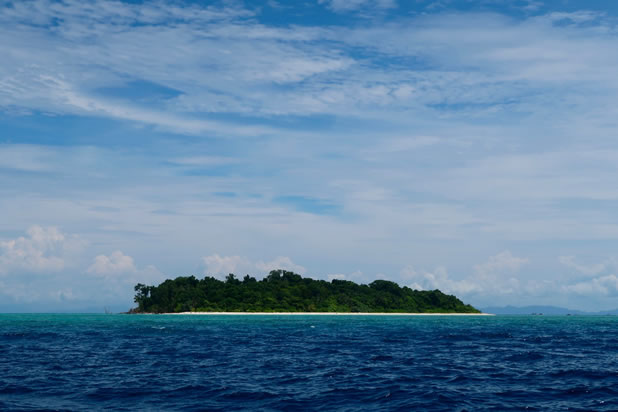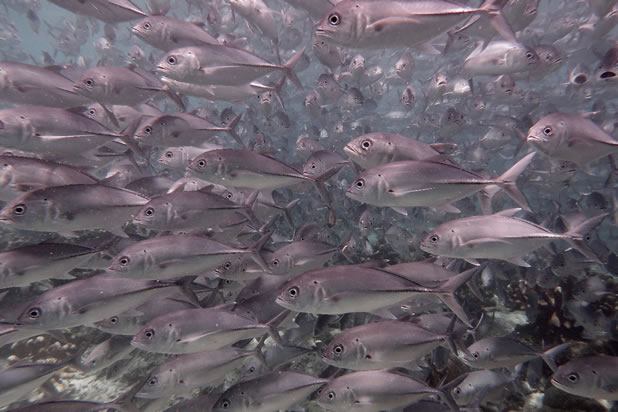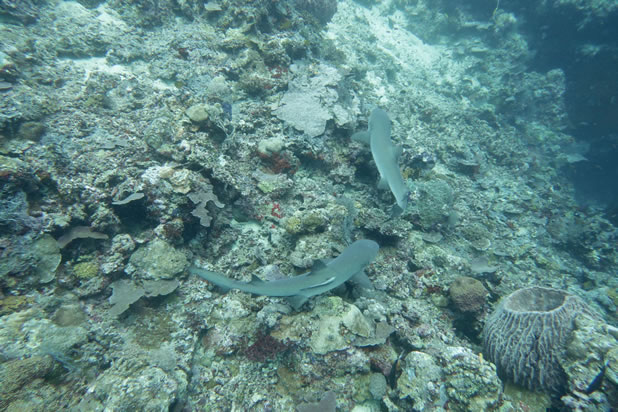|
Expeditions: SIPADAN
[Portuguese version bellow]
In July, the LECAR team represented by Carlos (Cadu) Ferreira, Moyses Barbosa and Cesar Cordeiro attended the
5th IMMC held in Malasya and, as an extension of the trip the team headed east after the meeting towards the
Coral Triangle, the center of our planets marine biodiversity. The trip started in Semporna where we got on a boat to
Mabul Island. Mabul is a small island populated by traditional fishing villages and dive resorts in striking contrast to
each other. In total, we explored six dive sites at Mabul, and another two dive spots on the nearby island, Kapalai.
Although there´s a high diversity of reef fishes and invertebrates, especially soft corals and ascidians, the reefs
showed several signs of sequential bleaching events reflected on the low hard coral cover and abundant coral
rubble, as indicated by another researcher we reencounter at Mabul, Dr. Tim McClanahan.
The highlight of the trip was the amazing Pulau Sipadan, situated 20km from Mabul. This island has been protected
since the 60’s by the Malaysian government and qualified as a National Park. The island is very popular among
recreational divers, and only 20 divers are allowed in the park daily, this way all dives must be planned in advance.
The island was visited by the captain Jacques-Yves Cousteau in the 70´s to document the populations of turtles
found in the only oceanic island in Malaysia. During the dives, the abundance of sharks along the huge walls, that
drop until 600m depth, was remarkable. We also spotted groups of white and black tips, besides some grey reef
sharks and a leopard shark. Bumphead parrotfishes are common in the shallow, but only few individuals were
seen around these colorful coral-rich areas. In fact, in many places, the coral cover is 100% with large plate corals,
and vast areas covered by branching Acroporids. No signs of bleaching could be noticed, and few things can be
compared with the sensation of swimming surrounded by schools big-eye trevallies (Caranx sexfasciatus), and
side-by-side with giant trevallies (Caranx ignobilis) as big as a diver. Closing this unique experience, we
encountered a large brindlebass (Epinephelus lanceolatus) within a cave, large green turtles (Chelonia mydas)
and, for the second time, a school of hundreds of barracudas (Sphyraena qenie) swirling close to the reef edge. The
remaining feeling after being into a place like that was shared by the three of us and others divers including our
dive guides; Sipadan is one of those special places where nature calls you louder. All that multitude of small
creatures, those fearless fishes and gentle giants invited us to share the message that Sipadan is special not
because it is different, but because it has been cared for a long time. It is probably too late for some places to return
to such a pristine condition, but we surely can restore ecosystems to healthier states using the correct
management actions, and be able to have beautiful and special places nearby again.
Written by: César Cordeiro September/2018
Em julho, a equipe do LECAR representada por Carlos (Cadu) Ferreira, Moysés Barbosa e Cesar Cordeiro
participou do IMMC5 realizado na Malásia e, como uma extensão da viagem a equipe rumou para o leste
após o congresso em direção ao Triângulo dos Corais, a região com maior concentração biodiversidade marinha.
A viagem começou em Semporna, onde pegamos um barco para a Ilha de Mabul. Mabul é uma pequena ilha
povoada por aldeias de pescadores tradicionais e resorts de mergulho, um contraste marcante. No total,
exploramos seis locais de mergulho em Mabul e outros dois pontos de na ilha vizinha, Kapalai. Embora haja uma
alta diversidade de peixes recifais e invertebrados, especialmente corais moles e ascídias, os recifes mostraram
sinais de eventos de branqueamento sequenciais refletidos na baixa cobertura de corais pétreos e na abundância
de fragmentos de coral, como indicado pelo Dr. Tim McClanahan, renomado pesquisador que reencontramos em
Mabul.
O destaque da viagem foi a incrível Pulau Sipadan, situado a 20 km de Mabul. Esta ilha foi protegida desde os
anos 60 pelo governo da Malásia e qualificada como Parque Nacional. A ilha é muito popular entre os
mergulhadores recreativos, e apenas 120 mergulhadores são permitidos no parque diariamente, desta forma
todos os mergulhos devem ser planejados com bastante antecedência. A ilha foi visitada pelo capitão
Jacques-Yves Cousteau nos anos 70 para documentar as populações de tartarugas encontradas na única ilha
oceânica da Malásia. Durante os mergulhos, foi notável a abundância de tubarões ao longo das enormes paredes,
que descem até 600m de profundidade. Nós também avistamos grupos de tubarões galha-branca (Triaenodon
obesus) e galha-preta (Carcharhinus melanopterus) recifais, além de alguns tubarões-cinza-de-recife
(Carcharhinus amblyrhynchos) e um tubarão-leopardo (Stegostoma fasciatum). Peixes-papagaio-cabeçudos são
comuns em áreas rasas, mas apenas alguns indivíduos foram vistos em torno dessas áreas ricas em corais
coloridos. De fato, em muitos lugares, a cobertura de coral atinge 100%, com grandes corais tabulares e vastas
áreas cobertas por Acroporídeos ramificados. Nenhum sinal de branqueamento foi notado, e poucas coisas
podem ser comparadas com a sensação de nadar cercado por cardumes de xaréus-pretos (Caranx sexfasciatus)
e lado a lado com xaréus-gigantes (Caranx ignobilis) do tamanho de um mergulhador. Fechando esta experiência
única encontramos uma garoupa-gigante (Epinephelus lanceolatus) na entrada de uma caverna, grandes
tartarugas-verdes (Chelonia mydas) e, pela segunda vez no mergulho, um cardume de centenas de barracudas
(Sphyraena qenie) circulando perto da borda do recife. O sentimento que ficou após estar em um lugar como
aquele foi unânime entre nós pesquisadores e outros mergulhadores incluindo nossos guias de mergulho.
Sipadan é um daqueles lugares especiais onde a natureza fala mais alto. Toda aquela vastidão de pequenas
criaturas, peixes sem medo e gigantes gentis nos convidaram a compartilhar a mensagem de que Sipadan é
especial não porque é diferente, mas porque foi conservada por um longo tempo. Provavelmente é tarde demais
para alguns locais voltarem a uma condição tão intocada, mas certamente podemos restaurar nossos
ecossistemas locais para estados mais saudáveis por meio de ações de manejo adequadas, e podermos
novamente ter lugares especiais e exuberantes em regiões mais próximas.

Puland Sipadan island view.

School of Bigeye Trevally (Caranx sexfasciatus)

White tip sharks (Triaenodon obesus)

School of barracudas (Sphyraena qenie)
|













